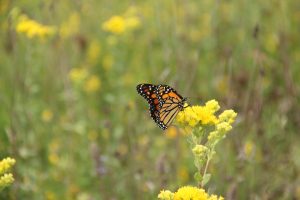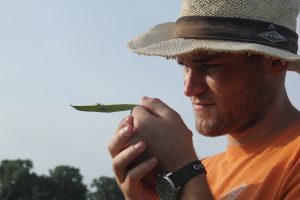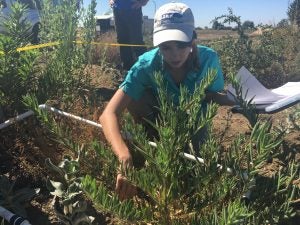
Monarch populations have declined by 90 percent in the past two decades due, in large part, to the loss of milkweed across the Midwest.
Once again, summer has brought the highly anticipated sightings of monarch butterflies across the country. An online tracker from Journey North shows the beloved orange and black butterflies fanning across the Northeast and Upper Midwest, where the eastern population is completing its northern migration. I spotted a monarch in Missouri just last week.
It’s a wonderful sight and an inspiring reminder of the monarch’s magical migration. But the opportunity to witness this natural miracle is dwindling. Over the last two decades, the monarch population has declined by 90 percent, bringing the butterfly dangerously close to extinction.
There are many factors contributing to this devastating loss, from climate change to deforestation. But a major contributor is the loss of milkweed habitat across the U.S., particularly in the Midwest where native prairies have largely been converted for agricultural use. Monarchs need milkweed to lay their eggs – eggs that turn into caterpillars that feed exclusively on the milky plants. So how do we restore this vital milkweed habitat where monarchs need it the most?
[Tweet “The Midwest can save the monarch butterfly. Learn how, via @GrowingReturns.https://edf.org/8hY”]
All hands on deck

Kyle Kasten, a researcher with the Monarch Lab at University of Minnesota, examines a monarch caterpillar at Duncanson Growers in Mapleton, Minnesota. Photo by Wendy Caldwell.
A group of researchers sought to answer this very question in a new study, Restoring monarch butterfly habitat in the Midwestern U.S.: “All hands on deck.” The study presents multiple scenarios for bringing milkweed back to the Midwest, which include restoration scenarios for protected grasslands, Conservation Reserve Program lands, rights of way (powerlines, railways and roadsides), urban and suburban lands, and agricultural lands.
After considering the biological potential for each of these sectors to support milkweed restoration, in addition to the probability of necessary management practices being adopted by each sector, the researchers concluded that “scenarios without substantive agricultural participation were insufficient for attaining the population goal.”
In short, we can’t restore monarch populations without the help of farmers and ranchers.
An innovative solution
The results of this study confirm what my conservation colleagues and I assumed as we have been working diligently over the last year to launch a new conservation program for monarchs that incentivizes participation from agricultural landowners. The goal of the program – called the Monarch Butterfly Habitat Exchange – is to effectively crowdsource conservation by deploying a new market-based platform that will significantly boost investment in restoration activities and maximize the impact of these dollars on the ground.

My colleague, Audrey Archer, using the Habitat Quantification Tool to count the number of milkweed and wildflower stems within a transect.
To do this, the Exchange uses a monarch butterfly Habitat Quantification Tool (HQT) to assess habitat value before, during and after a conservation or restoration project.
Together, the Exchange and accompanying HQT help landowners create five-star credit projects that can be sold to investors to provide the best bang for the buck, and for the butterfly.
The Exchange, dubbed an “Airbnb for butterflies,” is featured in the “all hands on deck” study as an example of how we can help create the future scenario where agricultural lands are contributing to monarch recovery.
“Innovative application of economic tools such as habitat exchanges may provide sufficient resources to tip the balance of the agro-ecological landscape toward a setting conducive to both robust agricultural production and reduced imperilment of the migratory monarch butterfly,” the authors wrote.
With the right tools in the right hands in the right places, we can meet ambitious recovery goals and effectively drive equally ambitious investments in monarch conservation at the scale and pace needed.
Related:
From testing to launch: A new program for monarchs takes flight >>
Monarchs still need milkweed, and farmers are growing it >>
How food companies can turn the pollinator emergency into a big opportunity >>










3 Comments
I would like to see all highway verges and center lines planted with milkweed, native wild flowers and grasses. No need for mowing.
i AM A LANDOWNER IN PHELPS COUNTY-12476 COUNTY RD 7530 65550
WE DID TALK WITH AN AGENT AND WANT TO PARTICIPATE WITHOUT USING HERBICIDES- IS THERE AN OPTION? WE WOULD BE WILLING TO TURN SEVERAL ACRES INTO MONARCH HABITAT/MILKWEED,ETC.
ALSO, NEAR I-44 EXIT 176 THERE USED TO BE PART OF THE INTERSTATE WHICH WAS MOVED. IT MAY BE AN IDEAL RIPARIAN WAY TO DO A MONARCH PROJECT. IT IS PARTIALLY PUBLIC LAND AND PARTIALLY PRIVATE. IT IS A SIZABLE STRETCH AND NOT USED FOR ANYTHING.
I HOPE THIS HELPS AND WE WANT TO BE INVOLVED. I ALSO HAVE WRITTEN A SONG WHICH IS PUBLISHED: “COME TO THE BUTTERFLY GARDEN”-WITH KIDS SINGING IT- IF YOU NEED IT.
Saw maybe one monarch this yr. in NE Ohio. I have a few milkweed plants here this yr. and hopefully they will spread! Love monarchs, makes me sick when I see them frozen in Mexico due to climate change.